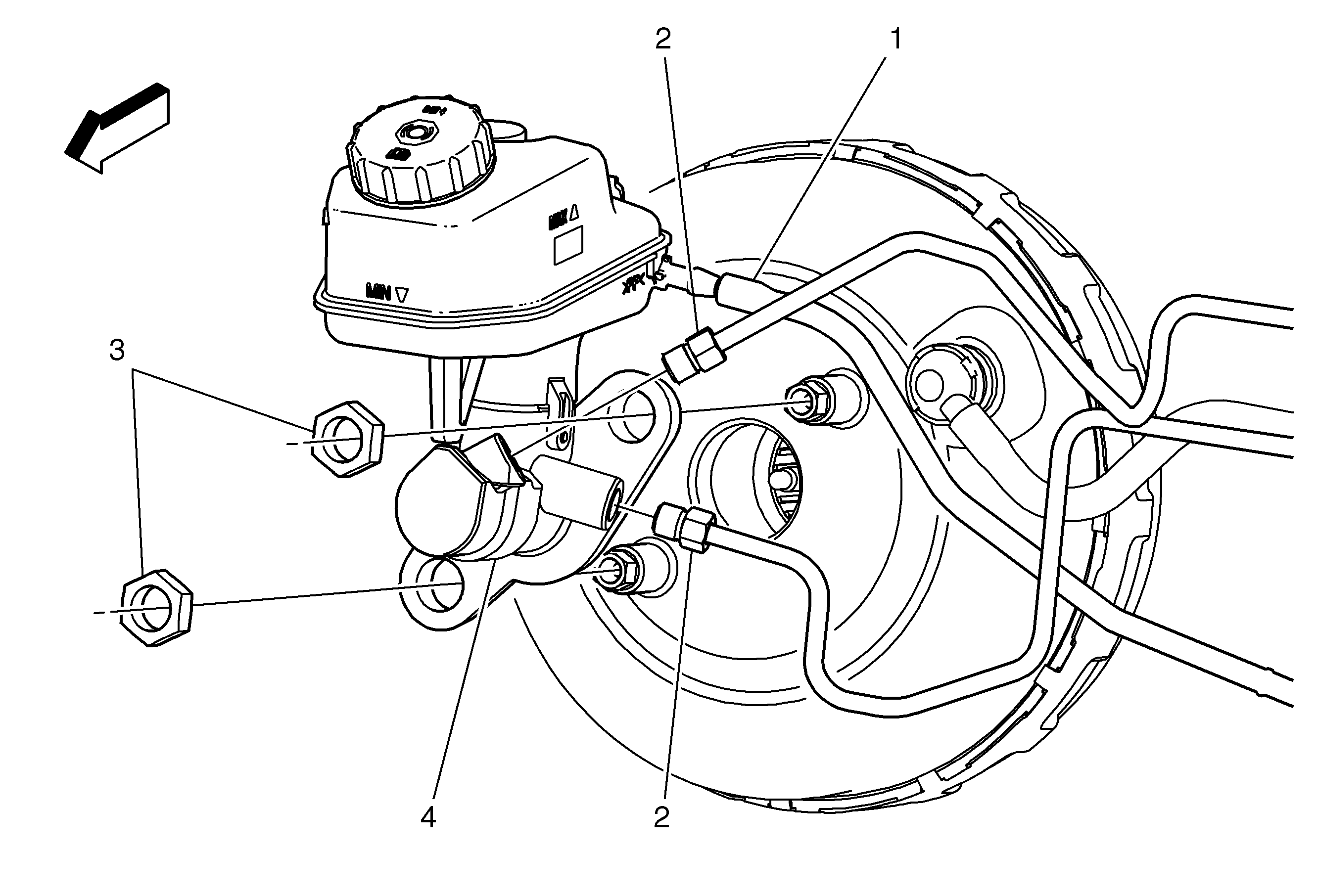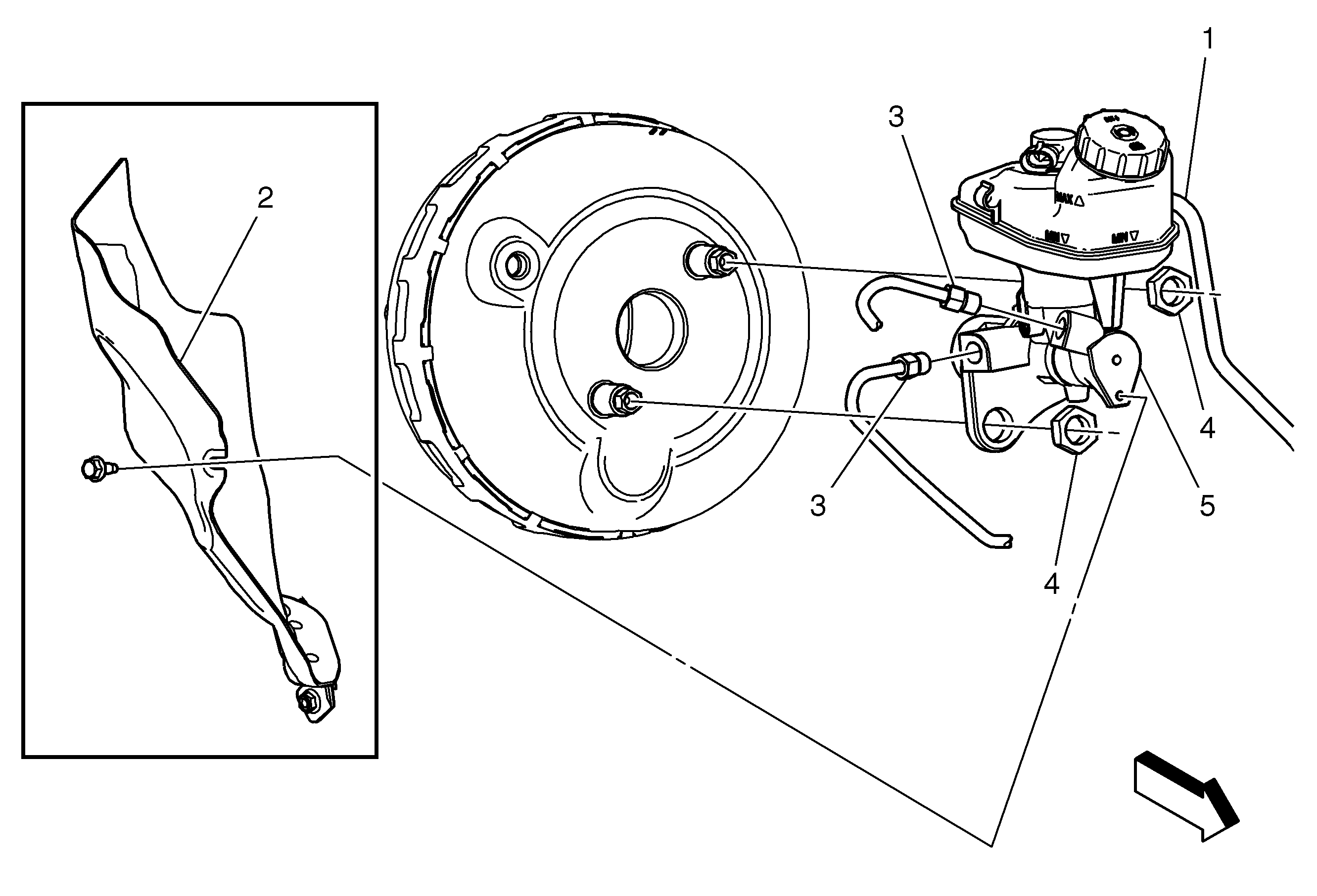Callout
| Component Name
|
|
Warning: Refer to Brake Fluid Irritant Warning in the Preface section.
Caution: Refer to Brake Fluid Effects on Paint and Electrical Components Caution in the Preface section.
Preliminary Procedures
- With the engine OFF, apply the brake pedal several times until the brake pedal becomes firm to deplete the vacuum brake booster vacuum reserve.
- Remove the brake fluid from the master cylinder reservoir, using a suitable suction device.
- Disconnect the brake fluid level sensor electrical connector.
|
1
| Clutch Master Cylinder Hose
Procedure
- If equipped, disconnect the clutch master cylinder hose from the brake master cylinder reservoir.
- Cap the brake fluid reservoir outlet and plug the clutch master cylinder hose inlet to prevent brake fluid loss and contamination.
|
2
| Brake Pipe Fittings
Caution: Refer to Fastener Caution in the Preface section. ProcedureCap the brake pipe fittings and plug the master cylinder outlet ports to prevent brake fluid loss and contamination.
Tighten
18 N·m(13 lb ft) |
3
| Brake Master Cylinder Nut (Qty: 2)
ProcedureInstall 2 NEW brake master cylinder nuts.
Tighten
50 N·m(37 lb ft) |
4
| Master Cylinder
Procedure
- When removing the master cylinder, ensure the master cylinder to booster seal between the vacuum booster and the master cylinder is properly seated in the groove at the rear of the master cylinder and is not damaged. Replace the seal if necessary.
- If necessary, remove the brake master cylinder reservoir. Refer to
Master Cylinder Reservoir Replacement.
- Fill the master cylinder reservoir.
- Bleed the brake system. Refer to
Hydraulic Brake System Bleeding.
- If equipped, calibrate the brake pedal position sensor. Refer to
Brake Pedal Position Sensor Calibration.
|
Callout
| Component Name
|
|
Warning: Refer to Brake Fluid Irritant Warning in the Preface section.
Caution: Refer to Brake Fluid Effects on Paint and Electrical Components Caution in the Preface section.
Preliminary Procedures
- With the engine OFF, apply the brake pedal several times until the brake pedal becomes firm to deplete the vacuum brake booster vacuum reserve.
- Remove the brake fluid from the master cylinder reservoir, using a suitable suction device.
- Disconnect the brake fluid level sensor electrical connector.
|
1
| Clutch Master Cylinder Hose
Procedure
- If equipped, disconnect the clutch master cylinder hose from the brake master cylinder reservoir.
- Cap the brake fluid reservoir outlet and plug the clutch master cylinder hose inlet to prevent brake fluid loss and contamination.
|
2
| Heat Shield Assembly
Caution: Refer to Fastener Caution in the Preface section. ProcedureIf equipped, unbolt the heat shield assembly from the brake master cylinder.
Tighten
9 N·m (80 lb in) |
3
| Brake Pipe Fitting
ProcedureCap the brake pipe fittings and plug the master cylinder outlet ports to prevent brake fluid loss and contamination.
Tighten
18 N·m (13 lb ft) |
4
| Brake Master Cylinder Nut (Qty: 2)
Procedure
- Discard the brake master cylinder nuts.
- Install 2 NEW brake master cylinder nuts.
Tighten
50 N·m (37 lb ft) |
5
| Master Cylinder
Procedure
- When removing the master cylinder, ensure the master cylinder to booster seal between the vacuum booster and the master cylinder is properly seated in the groove at the rear of the master cylinder and is not damaged. Replace the seal if necessary.
- If necessary, remove the brake master cylinder reservoir. Refer to
Master Cylinder Reservoir Replacement.
- If installing a new master cylinder, bench bleed the master cylinder.
- Fill the master cylinder reservoir.
- Bleed the brake system. Refer to
Hydraulic Brake System Bleeding.
- If equipped, calibrate the brake pedal position sensor. Refer to
Brake Pedal Position Sensor Calibration.
|


